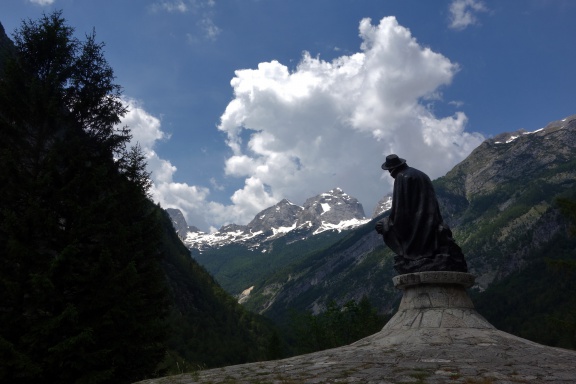Difference between revisions of "Triglav National Park"
(fertik) |
|||
| Line 65: | Line 65: | ||
===International projects=== | ===International projects=== | ||
* [http://www.palpis.org/ ''Palpis'' (Cross-border cooperation and cross-border management plans for conservation important areas in the southern Julian Alps)] (in Slovenian and Italian) | * [http://www.palpis.org/ ''Palpis'' (Cross-border cooperation and cross-border management plans for conservation important areas in the southern Julian Alps)] (in Slovenian and Italian) | ||
| − | * [http://www.tnp.si/get_to_know/projects/283 ''Alpencom'' (ALP ENvironmental COMmunication)] | + | * [http://www.tnp.si/get_to_know/projects/283 ''Alpencom'' (ALP ENvironmental COMmunication)] |
| − | * [http://www.tnp.si/get_to_know/projects/282 ''ERA - Eko region Alpe Adria''] | + | * [http://www.tnp.si/get_to_know/projects/282 ''ERA - Eko region Alpe Adria''] |
* [http://www.avis-gis.info/ ''AV.IS'' (Alps Visitors – InfoSystem – Natural Hazards)] (in Slovenian, English and German) | * [http://www.avis-gis.info/ ''AV.IS'' (Alps Visitors – InfoSystem – Natural Hazards)] (in Slovenian, English and German) | ||
[[Category:Monuments and sites]] | [[Category:Monuments and sites]] | ||
Revision as of 12:07, 24 August 2011
Administration
Triglav National Park is managed by the Triglav National Park Public Institute, based in Bled, which operates under the Ministry of the Environment and Spatial Planning. The professional and common services of the TNP Authority permanently employ 24 people, while the Professional Ranger Service employs 20 people and another 7 people work at the Trenta Lodge TNP Information Centre and Museum.
Protecting and conserving the TNP's ecosystem
The principal task of the Triglav National Park Public Institute is the protection and conservation of the pristine nature of the park, but it also carries out specialist and research tasks.
TNP has a very diverse ecosystem from the lowest point of Tolminka River 180 metres above sea level with narrow gorges to hills with vast forests and meadows to high mountain rocky landscape with rare protected plants and wild life. From 2003 the Alps and TNP have been protected by UNESCO as a biosphere reserve as part of the Sevilla strategy.
Rich autochthonous cultural heritage
Triglav National Park Public Institute is also responsible for preserving the autochthonous cultural heritage as the basis for sustainable development.
The cultural heritage of the park is very diverse and picturesque, because the park lies at the meeting point of various climates as well as various cultures, each of which have left a mark on the cultural heritage of the area. The Alpine cultural heritage connects Slovenes with the family of Alpine nations. In the past, 4 major economy branches prevailed in the region: iron foundries, charcoal-burning, forestry and Alpine dairy-farming. These economies also shaped the customs of the people living there. Today agriculture with its pastoral economy, crafts (wood and wool products) and tourism are the major economical activities in the park, with some 2,400 inhabitants and 1.6 million visitors per year.
The register of immovable cultural heritage with the Ministry of Culture contains 300 units within the area of the Triglav National Park; secular architectural heritage prevails, followed by memorial heritage, settlement heritage, religious architectural heritage and archaeological heritage.
Museums in TNP
A number of museums are located within the borders of the Triglav National Park, including the Slovenian Alpine Museum in Mojstrana, Upper Sava Valley Museum, Jesenice, the Kobarid Museum, Oplen House, the Museum of Alpine Dairy Farming, Stara Fužina and the Tolmin Museum. The park authority directly manages the following museum institutions Pocar Homestead, Mojstrana, Trenta Lodge TNP Information Centre and Museum and Triglavska Roža Information Centre. The latter is also the administrative centre of the Triglav National Park. A new information centre is scheduled to open in Stara Fužina near Bohinj Lake.
International collaboration
TNP is a member of the ALPARC, the international Alpine Network of Protected Areas. Within the European Union funding mechanisms (mostly Interreg programmes) TNP has been active in various regional projects such as Palpis (Cross-border cooperation and cross-border management plans for conservation important areas in the southern Julian Alps with the Italian National Park Prealpi Giuliae; 2000–2006), the Info centre of TNP at Bled (with National Park Hohe Tauern; 2005–2006), Alpencom (ALP ENvironmental COMmunication with the French Les Ecrins as a lead partner; 2005–2008) etc.
See also
- Slovenian Alpine Museum
- Pocar Homestead, Mojstrana
- Trenta Lodge TNP Information Centre and Museum
- Triglavska Roža Information Centre
- Museum of Alpine Dairy Farming, Stara Fužina
External links
- Triglav National Park official website (in Slovenian, English and German)
- Information Centre TNP Bled (in Slovenian, English and German)
- Triglav National Park on Wikipedia
- Panoramas of Triglav National Park on Virtual Guide to Slovene Museums and Galleries
International projects
- Palpis (Cross-border cooperation and cross-border management plans for conservation important areas in the southern Julian Alps) (in Slovenian and Italian)
- Alpencom (ALP ENvironmental COMmunication)
- ERA - Eko region Alpe Adria
- AV.IS (Alps Visitors – InfoSystem – Natural Hazards) (in Slovenian, English and German)




